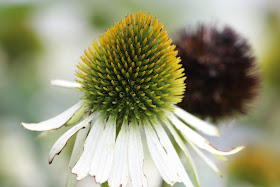September 17 was a busy day on our trip west. After visiting the Pony Express station in Gothenburg, Nebraska, and Chimney Rock, near the town of Bayard, Nebraska, we drove on to Scottsbluff, Nebraska, where we had a motel reservation for that night. After checking into the motel, we drove to the Scotts Bluff National Monument.
A sign at the National Monument says that emigrants were thrilled at the sight of the bluffs, rising some 800 feet above the valley floor, after the many weeks of plodding across the plains. But the landmark was also a barrier. There were badlands on the north side of the bluffs that were impassible for wagons, and deep ravines ahead barred the way to Mitchell Pass. It took engineering assistance from the U. S. Army to open the Oregon Trail through Mitchell Pass in 1851.
The sign pictured above is hard to read in the photo, but it gives you an idea of how the bluffs appeared to the travelers. South Bluff is on the left of Mitchell Pass, and Scotts Bluff is on the right.
Scotts Bluff
Lucy Foster Sexton, an emigrant on the Oregon Trail, wrote in her journal on June 13, 1849, "Made about 10 miles; halted about noon at Scotch [Scotts] bluffs,...a splendid pile of bluffs, probably nearly 400 feet in height, standing in an isolated position; the various views presented as we passed along our route were of large castles with their attendant offices, chapels, etc., magnificently grand, beyond any of the puny works of mortal man..."
Conestoga wagons were built with the floor curved upward to prevent the contents from tipping and shifting. The average size was 18 feet long, 11 feet high, and 4 feet in width. They could carry up to 12,000 pounds (5,400 kg) of cargo.
Out on the prairie, wagons spread out to avoid the dust stirred up by wagons in front. But, here at Mitchell Pass, there was a difficult bottleneck that forced the wagons to squeeze through narrow ravines in single file. Deep ruts, traces of which remain today, more than a century later, were gradually worn deep into the soft sandstone.
By the time we arrived at Scotts Bluff National Monument that evening, the Visitor Center was closed, as was the road to the summit. We explored as much as we could, then decided we'd just have to come back in the morning to drive to the summit before moving on to other destinations on our trip.
























































